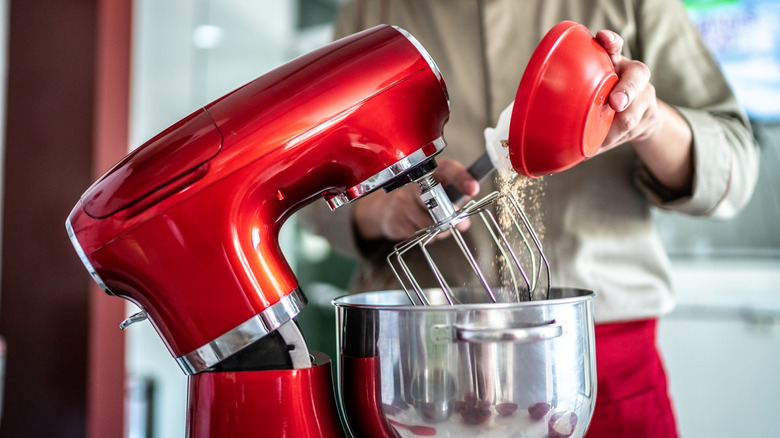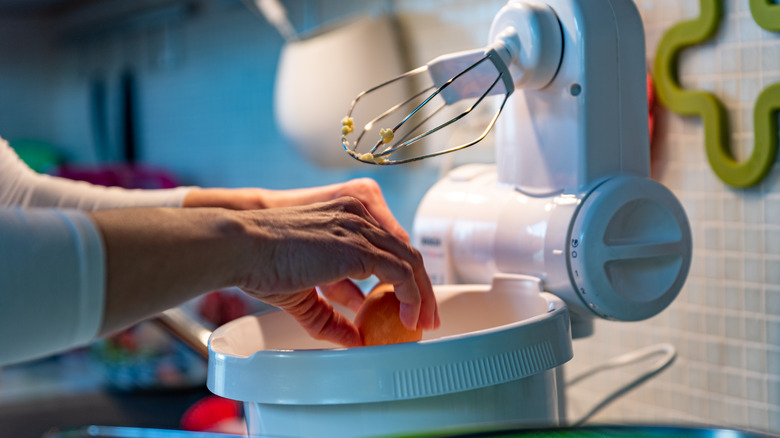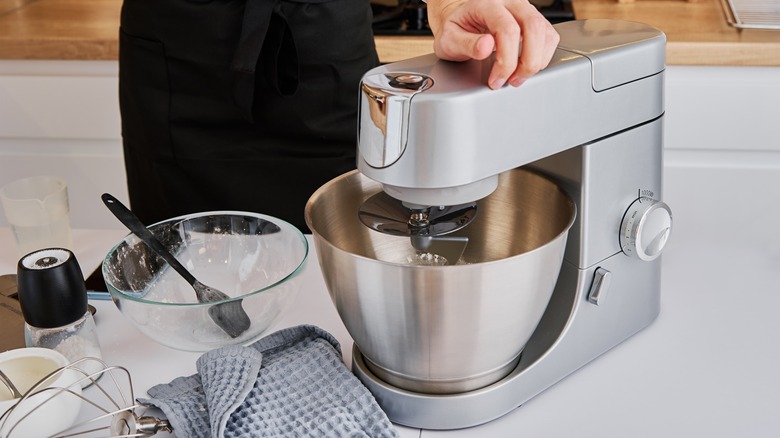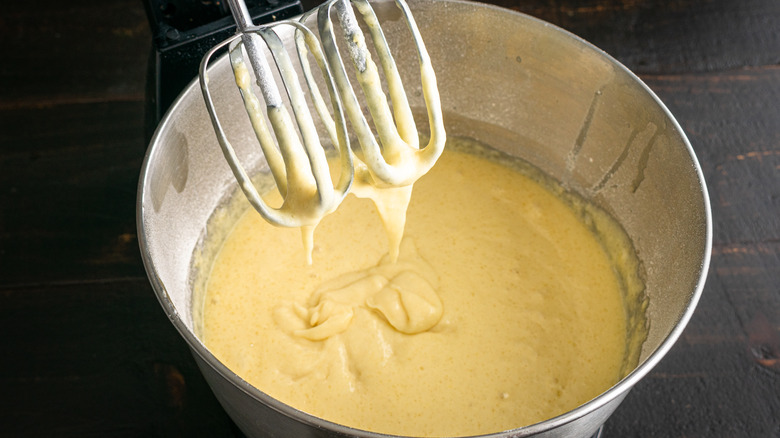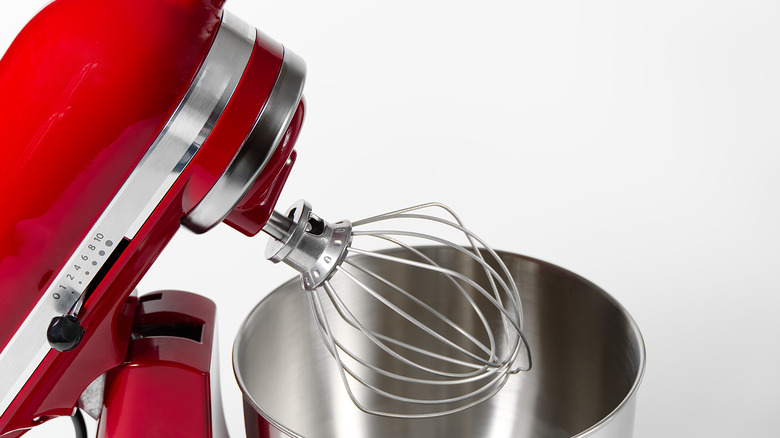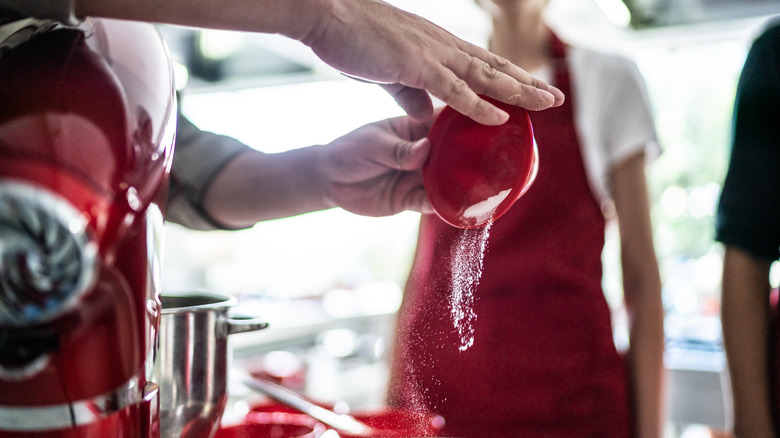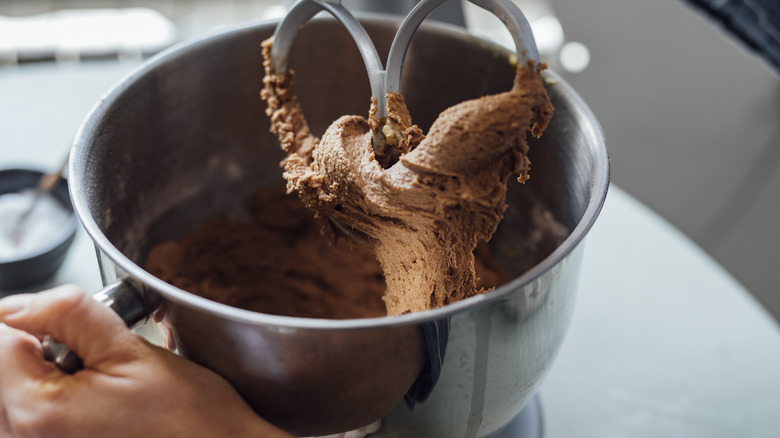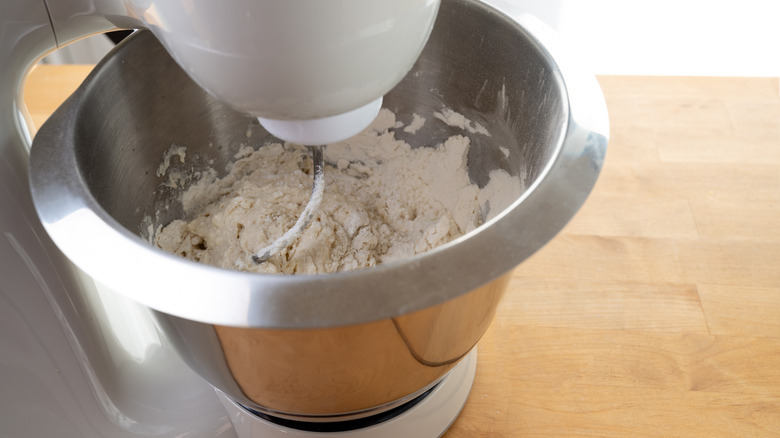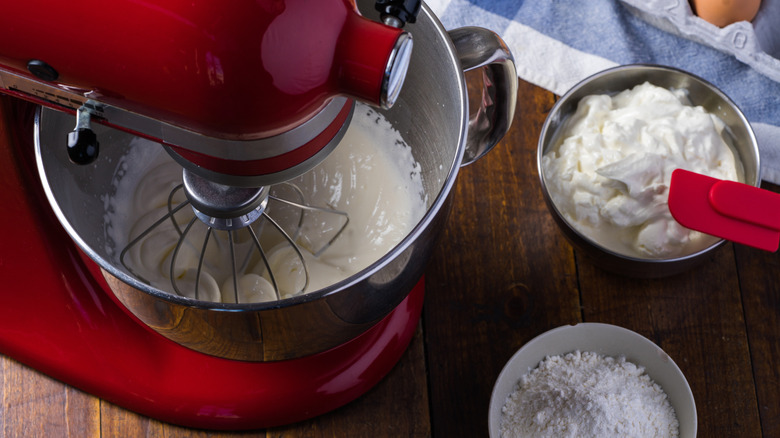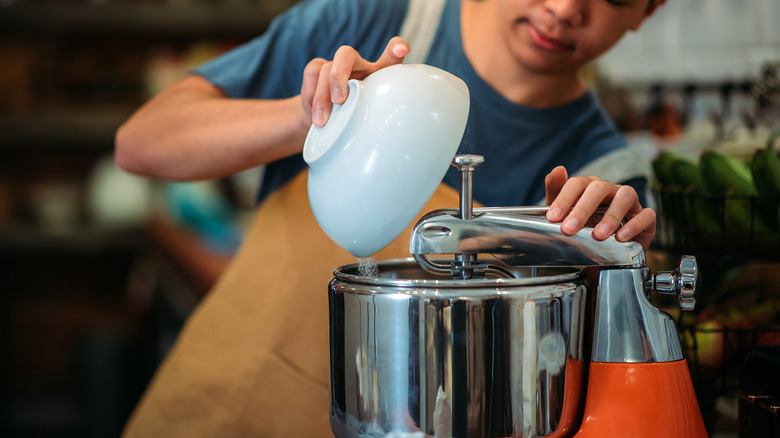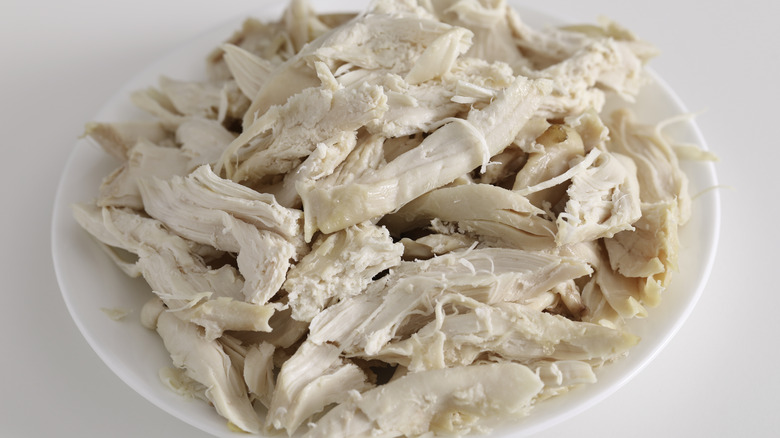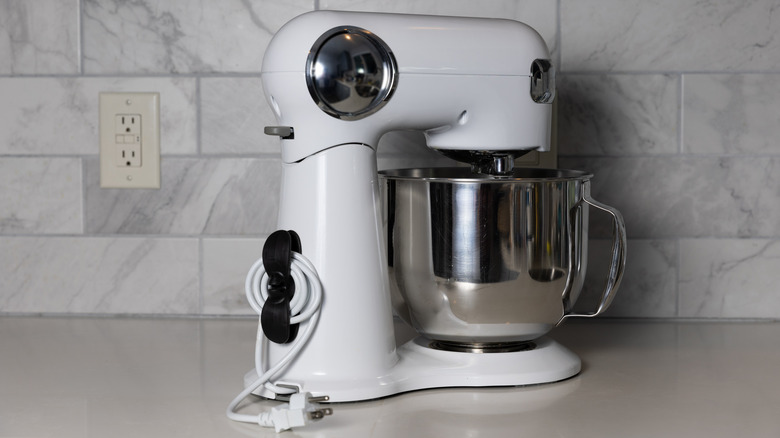13 Mistakes Everyone Makes When Using Their Stand Mixer
There are a lot of essential kitchen tools and appliances out there, but the stand mixer might be the one that saves you the most sheer physical effort — if you avoid some common mistakes. Stand mixers take all of the exertion out of combining ingredients and – unlike a hand mixer – you don't even have to hold them. Consisting of a large bowl and an electric mixing arm with several different attachments, these machines make short work of items as diverse as dough, dumpling fillings, and cake batters.
Perhaps what's most surprising about stand mixers is that while it seems like everyone has one, the market for them is still growing, with its value projected to grow by over 5% year-on-year until 2028, per The Insight Partners. With companies jostling to sell their products, it seems like there's always a shiny model ready to buy -– and with that, questions arise about how to use them, and whether that new mixer can be operated in the same way. The good news is that stand mixers are fairly standardized and easy to use. The bad news, though, is that there's a raft of mistakes that people make daily with their machines. Whether you have a brand-new model or a trusty old one, avoiding these blunders will ensure that your dish is perfect every time.
1. Forgetting to read the manual
If you're a dab hand in the kitchen and have had a stand mixer before, reading the instruction manual that comes with it might seem like a waste of time. However, whether you're a rookie or a veteran, you should always be doing so thoroughly. Your appliance's manual contains vital information about how to use it properly, how to clean it after use, and how to maintain it in the long term, as well as any crucial safety warnings you need to know. Neglect to read it, and you may end up with a broken appliance.
Additionally, throwing your manual out also means you might miss some nifty tips that come enclosed inside it. Some manuals provide information about what temperature your ingredients should be to ensure the best mix, like using room-temperature eggs and butter for the best cakes, and cold butter for your pastries. They can also provide vital information about what those additional attachments do and the best situations to use them in. As well as this, some instruction manuals may also carry your warranty information, which is vital if your machine breaks or malfunctions and you require a fix or replacement.
2. Starting on the highest speed
Stand mixers can whizz things together at top speed, and if you're in a rush this can seem like a dream. Flicking it to the highest speed immediately, however, can leave your kitchen, and your meals, in a serious mess. Going for the top speed instantly can cause your ingredients to shoot out of your bowl and across your countertop, especially if you're mixing dry items. It can also cause your ingredients to incorporate less effectively and might lead to less volume in recipes that require it, like meringues, as the egg proteins have less opportunity to loosen.
Flicking your mixer to the highest speed instantly can also damage it. If you go to the top speed straight away, it can wear out the mechanics and tax the mixer's engine, which can lead to deterioration of the appliance more rapidly. The combination of a high speed and a dense food item, like dough, can exacerbate this issue. Rather than destroy your mixer, you're far better off always starting on the lowest speed. You can of course crank it up eventually, but give your stand mixer time to warm up and acclimatize, and your ingredients time to meld together properly before doing so.
3. Filling your bowl too much
Most stand mixers come with a voluminous bowl attachment, which is big enough to mix multiple items for large portions. All things in life have a limit, however. If you fill up your bowl too much, you can limit the effectiveness of your appliance to mix the things inside. Overcrowding your bowl may mean that your food items don't incorporate as effectively, which can be made even worse if you're trying to mix slightly bulkier items, like pieces of fruit into a batter.
Overfilling your bowl can also cause strain on your machine as it tries to mix more than its motor can handle, and may cause a kitchen explosion, as your ingredients spill over the side and onto your work surface. Rather than cause this clean-up operation for yourself, it's always best to work in batches. If you know you're going to be mixing a large volume of items, divide them into equal portions and mix them separately. Once everything's done, you can then detach your bowl and use it to combine everything.
4. Forgetting to adjust your bowl clearance
Bowl clearance is one of those things that everyone forgets to consider when using their stand mixer, but it's incredibly important. Your bowl clearance is, essentially, the distance between your bowl and your beater. The more you use your stand mixer, the more this distance shifts slightly, and this can create inconsistencies with its mixing ability and how well everything incorporates, potentially having a knock-on effect on your dish.
It's always important to assess where exactly your mixing tines are reaching in your bowl and adjust your machine accordingly. This can usually be done by turning a knob or a screw located on the neck of your machine, often on the inside. Visually, it may not look as though things have changed much, but it will make a big difference to your overall dish. Bear in mind, though, that you probably don't need to adjust your bowl clearance too often, especially if you only use your stand mixer occasionally. Avoid the temptation to fiddle with it constantly, and only adjust it when you start to notice a difference in your clearance.
5. Leaving your splatter guard off your machine
Splatter guards come with stand mixers for a reason, folks. These attachments are vital for making sure that the food you're mixing doesn't fly all over your kitchen when you turn on your machine. While some stand mixers come with splatter guards already attached, certain lines like KitchenAid sell detachable splatter guards that you can buy separately and place on your appliance.
Splatter guards also come with an attached chute which allows you to pour your ingredients into your bowl without having to remove and replace them. When attaching your splatter guard, make sure that your machine is turned off, both at the wall and on the machine itself. Ensure that there's not too big of a gap between your splatter guard and your bowl's rim, as this can just leave space for the food to fly out. Like your bowl and your mixers, splatter guards should be cleaned after every use, so that food waste from your previous meal doesn't end up in the recipe you're currently making. Bear in mind that not every splatter guard will fit every bowl, even in the same product line, so check with the manufacturer before trying to attach one.
6. Not scraping your bowl
We all know that scraping the bowl and licking the spoon is one of life's great pleasures — so you'll be pleased to hear that we demand that you do it. You may need to leave the spoon lick until later, though, as we're talking about scraping your bowl down during the mixing process. As you mix, your food will coat the outer edges of your bowl, and most stand mixer attachments just don't have the reach to whip it back down into the main body of your food. Thicker ingredients, like butter, are more likely to become stuck to the outside. This can result in your food not being as well-mixed as it should be, and you losing vital flavor in your dish.
As you mix, therefore, you should be periodically turning your machine off and scraping down the outsides, to push the food gently back into the center of the bowl. Make sure you're using an appropriate utensil to do this, and one that won't scratch your bowl. A rubber spatula is perfect as it can bend to the shape of your vessel, ensuring that every last piece of food is scraped up. It's always best to do this after you add new ingredients to the bowl so that nothing is left half-mixed.
7. Not using all of your attachments
That stand mixer attachment that you left sitting in your box might be the thing you need the most. Different mixer attachments perform different functions, and picking the right one can vastly improve your food. The attachment we're all probably most familiar with, the balloon whisk, is perfect for incorporating air into your recipes. Although it can do a good job of mixing most things, it's especially good for things like meringues and frosting.
Flat beaters, meanwhile, can mix most things effectively, and while they don't aerate as well as balloon whisks, they're great for heavier recipes that need a bit more elbow grease, like mashed potatoes. For your dough, meanwhile, you should be using your dough hook. Dough hooks mimic the way the hand works when it's kneading dough, and its curved shape helps to develop its gluten structure and work through the dough itself, preventing it from getting pounded into a tight ball. Remember that you can mix and match in the same recipe; you don't just have to use one or the other the entire time.
8. Trying to mix all your ingredients at once
The beauty of a stand mixer is being able to dump everything in and leave it to work its magic. However, you shouldn't overdo it. Trying to mix all of your ingredients at the same time, without any prior incorporation going on, may leave you with a lot of mess. Dumping in all your flour with your wet ingredients and flicking your machine too high can cause an eruption, as the wet components force the dry ones out of the bowl and into your curtains, which will result in you having to start all over again.
So, instead, focus on adding things a little at a time. If you're making a cake with your stand mixer, for instance, you should aim to add about a third of the dry ingredients each time, which will allow them to mix gently and evenly. If you want to really play it safe, mix your wet and dry ingredients away from the stand mixer entirely. Fold them together gently with a spatula, before replacing the bowl and allowing the stand mixer to bring them together more thoroughly. By wetting the dry items, you'll prevent any spillages later on.
9. Leaving your stand mixer unattended while it's running
While stand mixers are generally pretty trustworthy, that trust should only go so far — and you should never leave it unattended while it's running. This is a serious hazard that can cause your mixer to topple off the countertop and break. Stand mixers are generally built to be pretty sturdy, to be able to withstand the motion created by the food being mixed. Certain food items, however, can cause it to rock slightly, particularly bulky ones like dough.
When this happens, your stand mixer can start to move away from its original position, and towards the edge of your counter. If it falls off, not only will your food go everywhere and your machine potentially be smashed into pieces, but it could also damage your kitchen floor and your wall as the plug rips out of it. By attending to it, you can ensure that it stays in place. You can also watch out for any other issues, like malfunction of the machine or overexertion from the motor, which may cause safety issues.
10. Forgetting to chill your mixing bowl
Contrary to popular belief, not everything should be mixed at room temperature. Certain food items benefit way more from being mixed in a chilled bowl. Yet way too many people forget that the detachable bowl on their stand mixer is usually made from metal and freezer-safe, and instead plow ahead at the regular temperature, slightly diminishing their food's quality in the process.
This is particularly true of whipped cream. Although you can whip cream at room temperature, doing so when it's cold can give you a lighter, fluffier result, thanks to the air bubbles introduced being held in place more effectively by the dairy fats. You can help this happen by keeping your cream cold, but if you're only going to dump it in a room temperature bowl — especially on a hot day — that cream will warm up very quickly, and your whipped cream will be slack and airless. If you don't have enough space in your freezer, even placing your bowl in the fridge will help to bring it down to a cool temperature. Just bear in mind that you'll likely need to leave it in there for a little longer to ensure that it's fully cooled.
11. Plugging your mixer into a power strip
Electrical outlets can be few and far between in a kitchen, and this can result in folks littering their space with an abundance of power strips. Although this can help you use multiple appliances without having to unplug and swap them endlessly, your stand mixer should never be plugged into one.
Stand mixers use a lot of energy, way more than power strips are designed to accommodate. If you try to operate one when plugged into a strip, you run the risk of it being overwhelmed and short-circuiting. This can cause melting or, in the worst case scenario, a fire, and can also lead to your appliance becoming damaged, which your warranty, unfortunately, usually won't cover.
In addition to this, your power strip really shouldn't be anywhere near your kitchen in the first place. They should never be used in wet areas, such as kitchens, as the moisture can cause electrical damage. Instead, you should only really be using them in dry environments where light-load electronics reside, like your home office or bedroom, and plugging in items like laptop and mobile phone chargers and small lights.
12. Only using your stand mixer for baking recipes
Think stand mixer, and you usually think of cakes, cookies, and cream. That's just the tip of the iceberg, though. Stand mixers can be used for way more than just baking, and what might surprise you is just how many savory recipes can be made much easier with them. Perhaps the most obvious of these is certain types of bread; bagels, pizza dough, and olive bread can all be made in your stand mixer, with your dough hook coming into its own.
Also excellent for making in your stand mixer are recipes based around ground meat, especially with certain attachments. Beer bratwurst can be made using a grinder attachment, with the other ingredients then being mixed by the regular mixer components. Wonton fillings and meatloaf can also be made easily, by dumping your ground meat into your bowl and mixing your other ingredients in on low. You can even use a stand mixer to shred chicken with no fuss whatsoever; it's as easy as placing boneless chicken into the mixer bowl, switching it to low, and mixing it for a minute or so until you're left with small, tender pieces.
13. Forgetting to clean it thoroughly
It may sound obvious, but cleaning your stand mixer properly after each use is essential –- and yet so many people forget to do it. Doing so doesn't just cause your food to taste terrible next time, as it absorbs all of the old food pieces that are still left on there, but in the long term, it can also cause your appliance to need replacing sooner.
Every time you use your stand mixer, you should remove the bowl and clean it thoroughly with hot, soapy water, drying it fully before you store it or re-attach it. You should also clean any attachments you use. While these can sometimes be placed in the dishwasher, check your manufacturer's instructions and wash them by hand if you're not sure. Make sure to wipe down your machine, too, using a damp cloth, to stop your machine from looking icky and prevent build-up in any of its gaps.
Every now and then, you should also perform a deep cleaning of your machine. Use a toothpick and cotton swabs to get into every crevice and joint, cleaning them out to prevent any clogging. Give the underside of your mixer a thorough wipe, and pay particular attention to cleaning around the underside of its neck.
